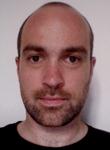|
In addition
to the podium, the jury of
the CSC examination is pleased to award a special distinction
to the five students below who obtained a mark of 30 and
ranked 4th.
|
4th Mark |
|
Christian ELSASSER |
University of Zürich -
Switzerland |
 |
|
I received my master degree in physics in 2011 from the University of
Zurich, working in the field of very rare B decays at the LHCb
experiment. Before I was setting up a test facility to monitor silicon
sensors using IR lasers. Subsequently to the master degree I started my
PhD thesis where I've continued the work on very rare B decays, mainly
in the context of particle identification. Further I am also developing
a tool to monitor the radiation damage in the silicon trackers of LHCb
and have just started to study hadronic tau reconstruction in LHCb which
will be used in many Electroweak as well as Flavour Physics analyses. |
|
|
Sergio FERNANDEZ CASADO |
CERN, Geneva - Switzerland |
 |
|
Currently I am working at CERN, in IT-OIS group. I work on the CERN
Search Project, an enterprise search solution where I have to support
all the operational aspects needed. I’m also doing several developing
tasks, like the creation/update of document extraction and processing
pipelines of the engine, automation on common tasks, or developing new
front-end webpages. Previously, I worked as a PHP web developer, as a
teacher, and as a RFID applications developer (including RFID devices
integration). I have experience
working with Windows and Linux, and I am comfortable developing in C#,
Java (ME and SE), C++, PHP, and nowadays, also with Python. |
|
|
Wolfgang KIESENHOFER |
Austrian Academy of
Sciences, Vienna - Austria |
 |
|
I studied physics at the Vienna University of Technology and did my
diploma thesis at the Institute of High Energy Physics were I analyzed
test beam data from semiconductor test structures measured at SPS. I am
now a PhD student, starting my 3rd year and I'm currently working for
the CMS experiment. My primary interest is the search for super
symmetry, but I also participated in the muon and the missing energy
object groups. I am currently
working on a background estimation technique for SUSY decay channels
with a single lepton in the final state. Operating systems I use in my
daily work are Linux and OSX, sometimes Windows.
Programming languages I am familiar with are C++, Python and
Matlab. I have also extensively used ROOT and RooFit during the last 4
years. |
|
|
Ramón MEDRANO LLAMAS |
CERN, Geneva -
Switzerland |
 |
|
I
work at the IT-ES group, in which I am the main developer and
coordinator of HammerCloud, the functional testing tool for grid sites
of ATLAS, CMS and LHCb. This tool submits more than 115,000 grid jobs
world-wide daily and has improved the ATLAS analysis reliability by 50%.
Also, I'm involved in the HelixNebula project, to develop a cloud
computing infrastructure for science. Finally, I'm becoming and ATLAS
Computing Manager on Duty. I
finished past year my Research MSc, after obtaining a MSc in Computing
in Spain and currently I am also working in my PhD. Before CERN, I have
worked at Google. I use, administer and maintain a cluster of 17
machines for HammerCloud, work with shell scripting, Python, SQL, high
replication and high performance clusters. |
|
|
Omar PERA MIRA |
CERN, Geneva -
Switzerland |
 |
|
I am a software engineer working
in the Computing Facilities group at CERN. Currently working in the
Lemon Team, where we develop and support the monitoring framework for
the CERN Computer Center. I am involved also in the new Agile
Infrastructure project, focused on the development of new monitoring
components that fits into the new infrastructure. Before coming to CERN,
I did an internship in the European Bioinformatics Institute in
Cambridge and the University of Bremen, with protein visualization and
semantic web as domain fields, respectively. In the last 2 years, I've
been launching Android applications in my free time. Originally from
Spain, looking forward to the CSC!
|
|
|





